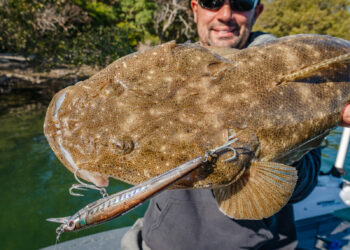WAHOO (Acanthocybium solandri) are tropical oceanic speedsters encountered by sportfishers throughout the world.
Wahoo are usually found in small groups or individually around offshore reefs, coral dropoffs and other pelagic features such as current lines and FADs. In this part of the world, they are found year round along the offshore reefs of the Great Barrier Reef, Coral Sea and the reefs off northern WA. But during the summer months their range extends south with the warm currents and they can be caught as far south as Perth on the west coast and even northern New Zealand.
With their small but incredibly sharp teeth, long streamlined bodies, high aspect ratio tail fin and brilliant cobalt blue stripes, to describe a wahoo as a hot rodded spanish mackeral is probably not too far off the mark.
Despite their mackerel-like appearance, some early scientific studies suggested that wahoo were closely related to billfish because like marlins, they lack gill rakers. However, later studies and recent genetic work have confirmed that wahoo are related more closely to scombrid fishes such as mackerels and tunas.
On the subject of genetics, researchers from the USA recently completed a study of the genetic structure of wahoo populations from around the world. They found no significant genetic differences between samples taken from wahoo all over the globe, which was a surprising result considering that most other tunas, billfishes, and oceanic sharks exhibit significant population structure between the worlds oceans. This suggests that adult wahoo and/or their larvae move freely from the Indian Ocean both eastwards to the Pacfic Ocean and westwards around the Cape of Good Hope into the Atlantic Ocean. The US researchers claimed their findings demonstrated that wahoo are the first known vertebrate with a single globally distributed population.
Like most other oceanic pelagic fish, wahoo are a fast growing, short lived species. A recent study found the average lifespan of wahoo was less than two years, with the size at maturity being 92cm for female fish, a size achieved in their first seven months of life. One tagged fish in the Caribbean grew 10kg in 10 months while the largest wahoo over 1.6 metres long are mostly females that can grow to around two metres long and live for up to nine years. This phenomenal growth is fuelled by a diet consisting almost entirely of fish, particularly pelagic baitfish, but also small tunas, flying fish, and squid. Spawning may be restricted to specific areas and times, however, few details are known. Wahoo have quite high fecundity, with over 6 million eggs per batch spawning being estimated for a 131cm long, 2-3 year old female, and up to 100 million eggs per season from larger females.
Besides their sweet eating qualities, wahoo are renowned for their speed. The wahoo’s burst swimming speeds are amongst the highest of all fish. As far back as 1964, scientists from the University of California measured wahoo swimming speed using modified sport fishing gear. Their technique was quite ingenious, given microcomputers and fancy satellite based tags didn’t exist at the time. They used an overhead reel with braided linen fishing line marked with iron powder at inch intervals, and measured the rate at which the line exited the tip guide using a magnetic pick up like those used in tape recorders. Using this primitive gear they found that a 113cm wahoo reached a peak speed of 77 km/h, or 18.9 body lengths/second, within the first 10 seconds after hookup. That’s over 21 metres a second. With a growth potential of over 2.1m and 83kg, it seems possible that a large wahoo could reach or even exceed a burst speed of over 100 km/h, a mark which might be exceeded only by much longer billfish.





















